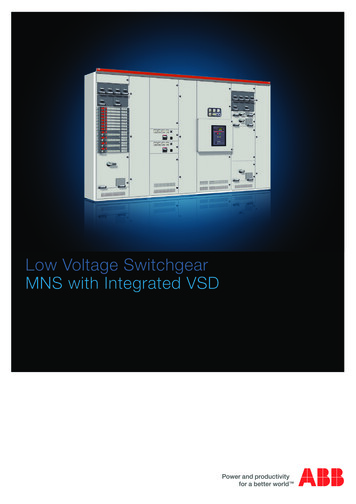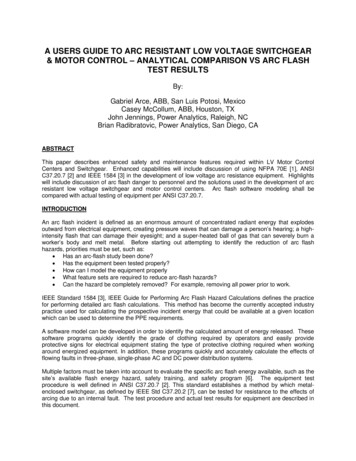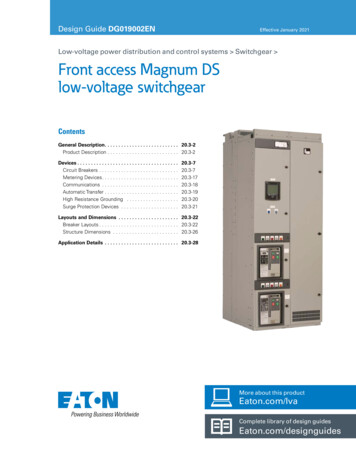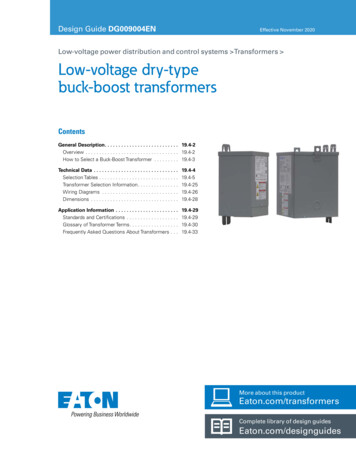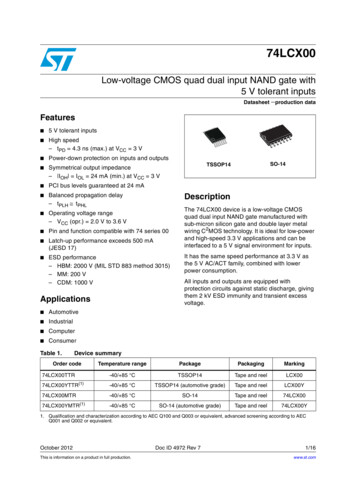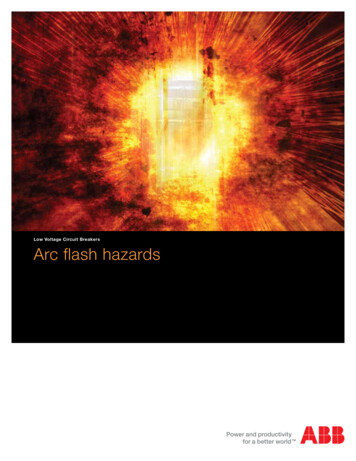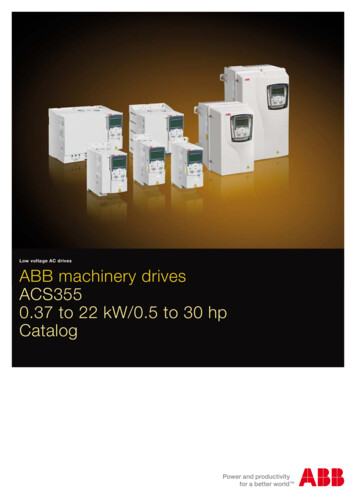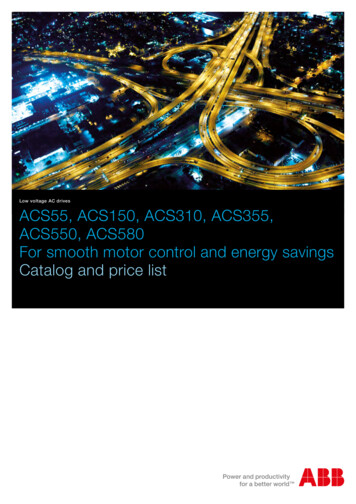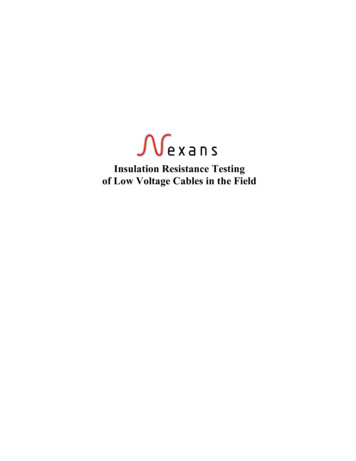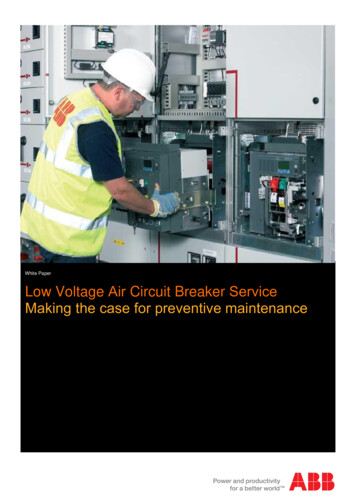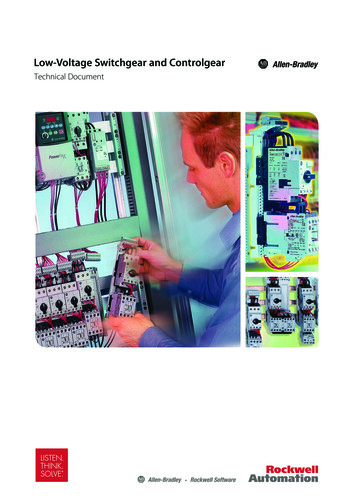
Transcription
Low-Voltage Switchgear and ControlgearTechnical Document
0-2LVSAM-WP001A-EN-P - April 2009
DisclaimerThe present document is designed to provide general technical information about the selectionand application of low-voltage switching and control devices and does not claim to provide acomprehensive or conclusive presentation of the considered material. Errors or changes – forexample as a consequence of changed standards or technical progress – cannot be excluded.This documentation has been worked out with utmost diligence. Nevertheless the authors andRockwell Automation do not warrant the correctness of the contents and recommendations andcannot exclude typing errors. Claims on the authors or Rockwell Automation based on thisdocumentation cannot be accepted. Rockwell Automation reserves the right to make changes atany time and at its own discretion. Correspondingly, qualified professional advice should beobtained before making decisions and initiating activities that could have an effect on technicalequipment.The authors thank the International Electrotechnical Commission (IEC) for permission toreproduce information from its International Standard:IEC 60947-1 ed.5.0 (2007) / IEC 60947-4-1 Am2 (2005) / IEC 60947-2 ed.4.0 (2006) / IEC60269-1 ed.4.0 (2006) / IEC 60947-8 ed.1.1 (2006) / IEC 60947-5-1 ed.3.0 (2003 ) / IEC 60038ed.6.2 (2002) / IEC 60079-14 ed.4.0 (2007).All such extracts are copyright of IEC, Geneva, Switzerland. All rights reserved. Furtherinformation on the IEC is available from www.iec.ch. IEC has no responsibility for the placementand context in which the extracts and contents are reproduced by the authors, nor is IEC in anyway responsible for the other content or accuracy therein.Rockwell Automation would like to thank the authors of the present document and their assistants for their valuable contributions.Authors:Dr. Werner Breer, Paul Hug, Urs Hunziker, Rey Kaltenrieder, Heinz Unterweger,Dr. Hans WeichertWith the inclusion of other specialistsCopyright 2009 by Rockwell Automation, Milwaukee, USALVSAM-WP001A-EN-P - April 20090-3
General preliminary commentsThe present technical manual is intended as an aid in project design and the application of lowvoltage switchgear and controlgear in switchgear assemblies and machine control. The focus ofthe document is on electromechanical switchgear, however electronic devices used in lowvoltage engineering have also been included. They are in many cases an effective alternative tomechanical devices.The discussions relate – insofar relevant – to the IEC standards, which correspond to theEuropean CENELEC standards. Where standards are quoted, the respective IEC designationsare listed. The numbering of the CENELEC standards (EN) largely corresponds to that of theIEC standards. National standards (e.g. DIN/VDE or BS) in some cases have differing numbering for historical reasons, but in terms of content are largely identical to the IEC and ENstandards, apart from rare national deviations. In relation to the requirements of other standardzones, especially in North America, reference is made to specific publications. The physicalcharacteristics are generally applicable.For switchgear combinations the standard IEC 60439-1 is referred to that is in effect at issuanceof this document. It is expected that IEC 61439-1 will shortly replace IEC 60439-1. The statements in the present documentation for switchgear assemblies also apply for IEC 61439-1.Statements made in this document concentrate on the underlying principles and facts and avoid– insofar as this is possible – stating technical data relating to specific products in order to avoidpremature obsolescence of the information contained. The applicable technical data about theproducts should be obtained from the latest valid product documentation as published in printedand “electronic” catalogs and electronic documentation like RALVET.0-4LVSAM-WP001A-EN-P - April 2009
0 Table of contents0Table of contents . .7.1.11.7.1.21.7.1.2.11.7.1.31.7.1.4Load characteristics and utilization categories. 1-1Utilization categories simplify the selection of devices . 1-1Electrical heating devices. 1-4Lamps and illumination equipment . 1-4Incandescent lamps. 1-4Halogen lamps. 1-4Discharge lamps . 1-4Transformers. 1-5Reactive power compensation and switching of capacitors. 1-6Reactive power compensation. 1-6Individual compensation . 1-6Group compensation . 1-7Central compensation. 1-7Switching of capacitors . 1-7Switching-on single capacitors . 1-8Switching of long, screened lines . 1-8Switching capacitors of central compensation units . 1-8Control circuits, semiconductor load and electromagnetic load. 1-9Three-phase asynchronous motors. 1-9Principle of operation . 1-9Slip-ring motors. 1-11Squirrel-cage induction motors . 1-12High efficiency motors . 1-14Influence of the voltage across the windings . 1-15Performance of squirrel-cage induction motors with changing frequency . 1-1622.1Switching tasks and selecting the appropriate switchgear. 2-1Electrical equipment complying with standards and matchingthe application requirements. 2-1Basic switching tasks and criteria for device selection . 2-1Device types . 2-2Disconnectors (isolating switches). 2-2Load switches . 2-3Switch disconnectors . 2-3Circuit breakers. 2-3Supply disconnecting devices. 2-3Supply disconnecting EMERGENCY STOP devices. 2-4Summary supply disconnect and EMERGENCY STOP devices. 2-5Fuses . 2-5Devices for thermal protection . 2-5Contactors . 2-5Parameters for the correct selection and sizing. 2-5Rated isolation voltage Ui . 2-7Rated operational voltage Ue, rated operational current Ie and utilization category 2-7Rated impulse withstand voltage Uimp . 2-7Short-circuit withstand capacity and short-circuit protection . 2-9Joule integral I2t . 2-10Cut-off current ID . 2-10Rated short-time withstand current lCW . 32.3.42.3.4.12.3.4.22.3.4.3UUULVSAM-WP001A-EN-P - April 20090-5
4.7.52.4.7.60-6Current limiting protective equipment . 2-11Coordination of electrical equipment . 2-12Coordination in respect of the switching capacity of the contactor(overcurrent selectivity). 2-12Coordination with respect to the operability after a short-circuit . 2-13Short-circuit switching capacity. 2-14Rated short-circuit making capacity Icm . 2-14Rated short-circuit breaking capacity Icu and Ics . 2-14Thermal protection. 2-15Ambient temperature . 2-15Operational overcurrents, heavy-duty starting. 2-15Life span . 2-16Prospective service life . 2-17Mechanical life span . 2-17Electrical life span. 2-17Intermittent and short-time duty, permissible frequency of operation . 2-20Intermittent duty and relative ON-time . 2-22Rated frequency and harmonics. 2-24Safety clearances . 2-24Mounting position. 2-25Protective separation . 2-25Site altitude . 2-26Shock and vibration . 2-26Specific application conditions and switching tasks. 2-27Parallel and series connection of poles . 2-27Parallelling . 2-27Series connection . 2-27AC switchgear in DC applications. 2-28Applications at supply frequencies 50 Hz and 60 Hz. Effect of harmonics. 2-29Effect of the supply frequency on the thermal load. 2-29Effect of the supply frequency on the switching capacity . 2-31Performance of release units at supply frequencies 50 Hz and 60 Hz . 2-32Switchgear used with soft starters . 2-32Switchgear for use with frequency converters (inverters) . 2-33Application of four-pole switchgear devices. 2-35Applications of switchgear with 4 NO contacts . 2-35Applications of switchgear with 2 NO and 2 NC contacts . 2-36Applications of switchge
General preliminary comments The present technical manual is intended as an aid in project design and the application of low-voltage switchgear and controlgear in switchgear assemblies and machine control.

